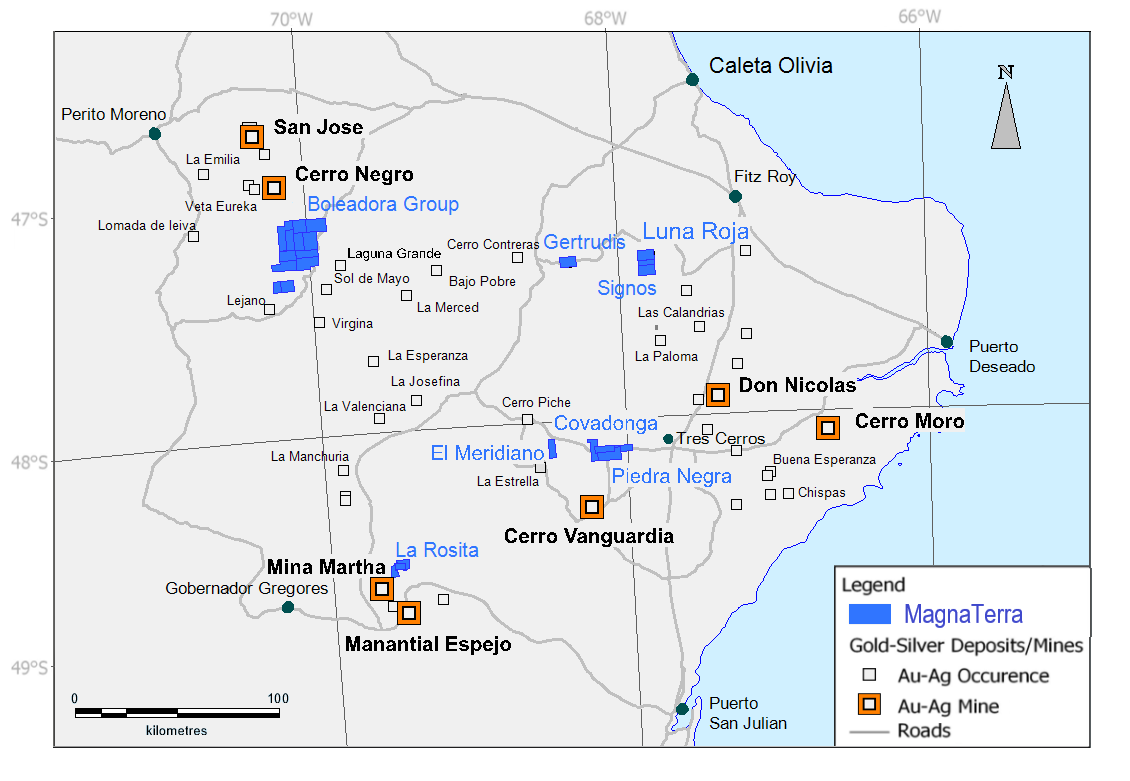
Magna Terra Minerals controls 89,000 Hectares of exploration rights in the mining-district of Santa Cruz Province of Argentina. The concessions lie entirely within the Deseado Massif, a "Large Igneous Province" (LIP) that is host to epithermal precious metal mineralization associated with Jurassic volcanism and crustal extension. The Massif occupies the northern part of Santa Cruz Province and is in an early-stage of exploration and development. Mining infrastructure is developing rapidly and most of our projects occur in close proximity to producing Au and Ag mines such as Cerro Vanguardia, Cerro Negro, San Jose, Mina Martha, Manantial Espejo, Cerro Moro and the newly developed Don Nicolas.
The Luna Roja project hosts fault and stratigraphically controlled, disseminated, Au and Ag oxide and sulphide mineralization and has enjoyed significant investment in mapping, rock chip sampling, soil sampling and trenching in additional to an IP program.
Exploration on the project culminated in a first phase drilling program constituting 1184 meters of diamond core in 8 holes. Drilling was completed between January 12th, 2019 and January 31st 2019, in a program designed to test three target areas – Cruz Del Sur, Orion and Estrella del Norte. The program resulted in a discovery in the Cruz del Sur Zone where the best drill hole, LR_DDH002, intersected 75.0 m of 0.62 g/t Au and 5.6 g/t Ag (from 37.0 m to 112.0 m). The deepest part of the zone, which is oxidized, included 42.0 m of 1.01 g/t Au and 4.6 g/t Ag (from 68.0 m to 110.0 m), indicating increased grade with depth.
The Mineralized footprint of this project constitutes approximately 3Km by 800m of surface mineralization associated with shallow fault and strata-bound targets.
The Boleadora group, to the south of Cerro Negro, constitutes a large greenfields exploration land package (approx. 55,000 hectares) encompassing 12 individual MD’s or exploration licenses. During first pass prospecting we utilized proprietary remote sensing and data analysis techniques to support BLEG and rock chip campaigns which revealed the area to be of strategic interest.
The ground and is under an agreement to sell to Oroplata S.A.(“Oroplata”) a subsidiary of Newmont Corporation (“Newmont”) who will pay Magna Terra (Atala) US$1 million as follows: $25k was paid on signing and six instalments totalling $975k are payable within six years from the date of the Agreement. In addition, Newmont (Oroplata) has granted a 2% NSR to Magna Terra (Atala) on the Boleadora package. The royalty can be reduced to 1% by payment of US$2.5M by Oroplata to Atala at anytime, and the gross royalty payable is capped at US$20M.
The Piedra Negra Project constitutes a zone of low sulphidation veins and stockworks in outcrop and float over a 2 km strike length and 700m width. Results from 460 surface rock chips reported and average grade of over 4690 ppb Au. Geological mapping on this project, combined with ground magnetic and IP surveys were used to define a 860 m drill program which we implemented in 2018. Drill hole PN_DDH006 intersected 2.0 m of 0.655 g/t Au (from m 14 to 16) and then 1.0 m of 0.18 g/t Au (from m 26 to 27). The hole collared in argillized tuffs, and after 14 m, cut low sulphidation vein material. Further anomalous intercepts are reported in Holes PN_DDH001, 2, 4 and 7 and occur over an area of 700 by 500 m.
The Covadonga project exhibits a significant mineralized footprint from rock chips with anomalous Au, Pb, As and Hg over a 3 km strike length in veins and hydrothermal breccias. Trenching has revealed low level Au with a very high correlation coefficient to Pb in argillic alteration in volcanics. A soil sampling program comprised of 694 samples and a program of ground magnetic and IP surveys have been completed and drill targets have been defined.
The Gertrudis Project is comprised of two mineralized structures which we refer to as the Gertrudis and David veins. These veins are some 300m apart, sub parallel and steeply dipping and are comprised of silicified tectonic and volcanic breccias with argillic alteration halos. Low grade Au anomalies occur in both veins which are also associated with As, Sb and Hg anomalies. The Gertrudis vein is the more prominent of the two and extends for 800m. This is a NNW striking structure which is steeply dipping to the WSW, and is well exposed along most of its length. The David Vein is exposed for 350m and does not exhibit a measurable dip. We have completed ground magnetic and IP surveys on this project and drill targets have been defined.
El Meridiano and La Rosita projects both have historic drilling dating back to 2010 with reportable but sub-economic Au mineralization. We have implemented CSAMT and IP programs respectively, on these projects and they are currently under evaluation for future exploration.